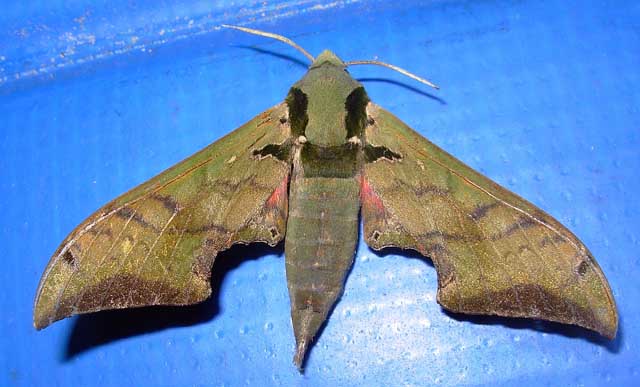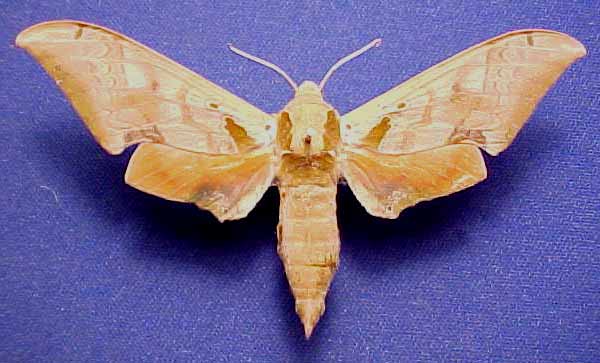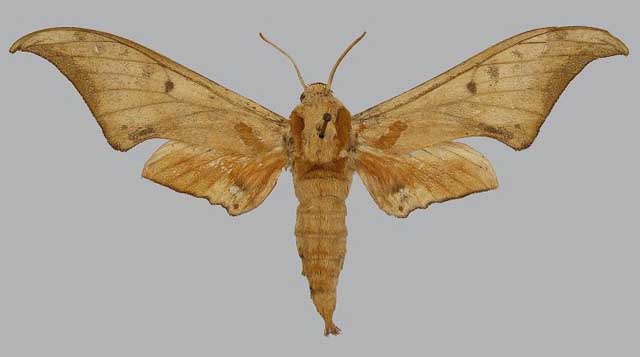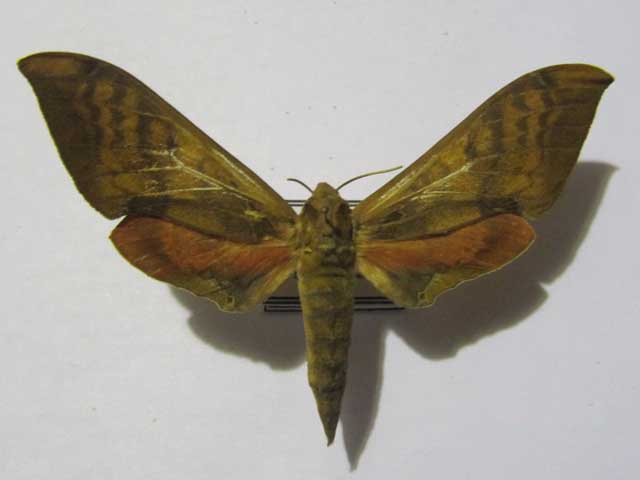Orecta lycidas eos
|
|
Updated as per
AN ANNOTATED CHECKLIST OF THE SPHINGIDAE OF BOLIVIA, October 2007
Updated as per Hawkmoths of Argentina, More, Kitching, Cocucci, 2005; October 6, 2011
Updated as per CATE, October 6, 2011
Updated as per BOLD, October 6, 2011
Updated as per personal communication with Leonardo Aguado (Entre Rios, November 2010); October 6, 2011
Updated as per personal communication with Ezequiel Osvaldo Núñez Bustos (Entre Rios, March, 2011); May 13, 2012
Updated as per personal communication with Joanna Rodriguez Ramirez (Tucuman; Argentina), January 22, 2015
Updated as per personal communication with Ezequiel Bustos (Shilap revta. lepid. 43 (172) diciembre, 2015, 615-631 eISSN 2340-4078 ISSN 0300-5267), January 4, 2016
|
Orecta lycidas eos
(Burmeister, 1878)
Philampelus

Orecta lycidas eos, El Palmar National Park, Entre Rios, Argentina,
March 7, 2011, courtesy of Ezequiel Osvaldo Núñez Bustos.
This site has been created by
Bill Oehlke at oehlkew@islandtelecom.com
Comments, suggestions and/or additional information are welcomed by Bill.
| TAXONOMY:
Superfamily: Sphingoidea, Dyar, 1902
Family: Sphingidae, Latreille, 1802
Subfamily: Sphinginae, Latreille, 1802
Tribe: Smerinthini, Grote & Robinson, 1865
Genus: Orecta, Rothschild & Jordan, 1903
Species: lycidas eos, (Burmeister, 1875) |
MIDI MUSIC
"What.A.Wonderful.World"
copyright C. Odenkirk
MIDI CITY
ON.OFF
<bgsound src="world.mid" LOOP=FOREVER>
|
DISTRIBUTION:
Orecta lycidas eos flies in
eastern Argentina: (Buenos Aires, Corrientes, Misiones (HoA)), (Entre Rios (LA/EB); Tucuman (JRR));
Paraguay;
Brazil: Espirito Santo (CATE); and
Bolivia: (Chuquisaca (2000m) (JH)).
CATE only indicates Uruguay: Montevideo; and Brazil: Espirito Santo.
BOLD indicates Argentina.

Orecta lycidas eos
courtesy of John Vriesi.

Orecta acuminata, CATE Sphingidae
There appears to be considerable fading of grab green to orangey brown as specimens age.
In the nominate subspecies, the forewing apex is quite produced and bluntly pointed, but not truncated or excavate as in Protambulyx and Adhemarius species.
The forewing pattern is highly variable, ranging from a highly contrasting series of lines and patches to almost unmarked.
Slightly darker, dentate median and post median lines are followed by a suffusion of light greyish-white, diffuse scaling.
Also in the nominate subspecies, the dark colouration on the thorax is a good match for all of the following forewing characters: 1) small basal dot near body;, 2) broad, distal basal band not quite
reaching the costa; continuing with 3) a separate, slightly distal suboval patch bordering the lower edge of the costa; 4) a small preapical parallelogram on and
below the costa, broken by thin white line on lower edge of the costa; 5) a subtrapezoidal patch along the inner margin, atop the slightly excavate region
preceeding the anal angle. On the hindwing there is same coloured small dot near the anal angle. All of the dark regions, including the thoracic areas are outlined with
thin white lines.
The lighter colouration of the thorax (shoulders and center) is a good match for the following areas on the forewing: 1) most of the costa except for the darker,
preapical parallelogram; 2) upper sixth of median area; 3) an elongate costal apical patch distal to paralleogram; 4) a region atop the darker trapezoidal patch
along the inner margin; and on the hindwing the same colouration in a diffuse band along the slightly crenulate outer margin from the small dot near the anal angle,
running approximately half way to the apex.
The forewing cell spot is not prominent, being masked by a slightly darker region.
In subspecies Orecta lycidas eos, the median and post median lines are more prominent (darker), more broadly diffuse and are without the outer
suffusions of greyish-white scales. The dark markings are not accentuated with a thin, yet distinct greyish white outline as in the nominate subspecies.
The cell spot is much more distinct although diffuse.
The overall forewing ground colour is more consistent in eos, but in both species the forewing subterminal and terminal areas are dark.
The specimen depicted in Hawkmoths of Argentina is a good match for Orecta lycidas eos, but it is not as boldly marked as the image supplied by
Leonardo Aguado, which may be something not yet described.

Orecta lycidas eos?? San Jose, Depto Colon, Entre Rios, Argentina,
November 2010, courtesy of Leonardo Aguado,
determination (tentative) and notes (blue and green) above, by Bill Oehlke.
I feel the specimen from Entre Rios, although more boldly marked, is consistent with wing shape and general characters of
Orecta lycidas eos. I believe Orecta acuminata is found only in north western Argentina and Paraguay and has forewings with apices much more
narrowly produced. Those two species, along with nominate lycidas, are the only Orecta reported for Argentina. Perhaps the image supplied by Leonardo
is of a species or subspecies not yet described.
FLIGHT TIMES AND PREFERRED FOOD PLANTS:
Orecta lycidas eos adults are on the wing in Entre Rios in November (LA).
Orecta lycidas eos larvae feed upon plants in the Lauraceae
family.
ECLOSION, SCENTING AND MATING:
EGGS, LARVAE AND PUPAE:
Larval Food Plants
Listed below are primary food plant(s) and alternate food
plants.It is hoped that this alphabetical listing followed by the
common name of the foodplant will prove useful. The list is not
exhaustive. Experimenting with closely related foodplants is worthwhile.
Lauraceae .......
|
Lauraceae
|
Ezequiel Bustos image:
Colección de Lepidoptera Proyecto DNA Barcodes Lepidoptera Argentina
Museo Argentino de Ciencias Naturales ¨Bernandino Rivadavia¨ (MACN)
Av. Angel Gallardo 470 (1405)
Ciudad de Buenos Aires
Argentina
Return to Main Sphingidae Index
Return to Smerinthini Index
Use your browser "Back" button to return to the previous page.
This page is brought to you by
Bill Oehlke and the
WLSS. Pages are on space rented from Bizland. If you would like
to become a "Patron of the Sphingidae Site", contact Bill.
Please send sightings/images to Bill. I will do my best to respond to
requests for identification help.
Enjoy one of nature's wonderments: Live
Saturniidae (Giant Silkmoth) cocoons.
 | 
Show appreciation for this site by clicking on flashing butterfly to the left.
The link will take you to a page with links to many insect sites. |





